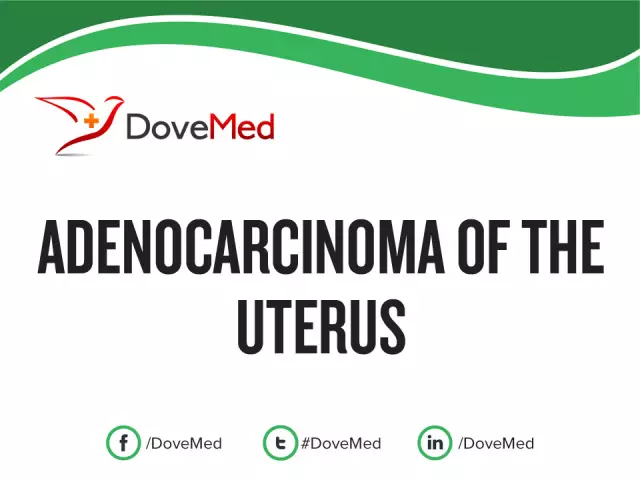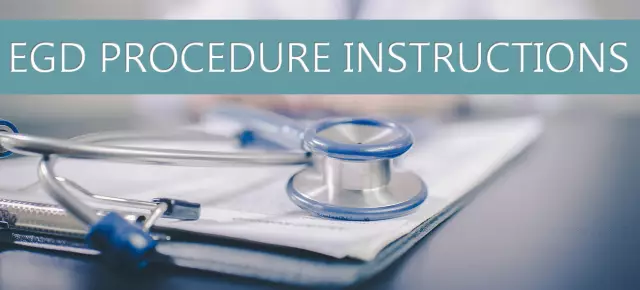- Author Rachel Wainwright [email protected].
- Public 2023-12-15 07:39.
- Last modified 2025-11-02 20:14.
Hernia of the stomach
The content of the article:
- Causes and risk factors
- Forms of the disease
- Symptoms of a gastric hernia
- Diagnostics
- Stomach hernia treatment
- Possible complications and consequences
- Forecast
- Prevention
A gastric hernia is a type of hiatal hernia, in which there is a complete or partial penetration of the stomach into the chest cavity.

Forms of gastric hernia
The chest and abdominal cavity are separated by a muscular septum - the diaphragm. The dome of the diaphragm is directed upward. In several places of the diaphragm there are holes through which the esophagus, blood vessels and nerves pass. The esophagus connects to the stomach, passing from the chest cavity to the abdominal cavity through the esophageal opening, which is located at the back of the diaphragm and consists of the digestive tube and the anterior vagus nerves. Normally, the esophagus is securely held in the esophageal opening, and the muscles and connective tissue fibers of the diaphragm do not allow the abdominal organs to penetrate the chest. With the development of a hernia of the stomach, the ligaments in the area of the esophageal opening of the diaphragm weaken. For this reason, the esophagus, and then the stomach, with an increase in intra-abdominal pressure, penetrate into the chest cavity.
Gastric hernia in children is diagnosed in about 9% of cases; with age, the risk of the disease increases. Women suffer from this pathology more often than men.
Causes and risk factors
Hernias of the stomach more often occur in elderly and senile people, which is associated with the natural aging processes. Connective tissues eventually lose their elasticity and atrophy, connective tissue structures weaken.
The main factors that can provoke the occurrence of a gastric hernia are conditions in which intra-abdominal pressure increases. These conditions include chronic diseases of the respiratory and digestive systems, overweight, excessive physical exertion, sharp bends, blunt abdominal injuries, and multiple births. In children, the cause of the disease is often anomalies in the development of the esophagus in the prenatal period.

A hernia of the stomach is more often diagnosed in old age, which is associated with natural aging of the body
A hereditary predisposition is of no small importance in the development of the pathological process.
In addition, risk factors for developing a gastric hernia include:
- the transferred surgical interventions;
- a sharp decrease in body weight;
- alcohol abuse;
- smoking;
- binge eating.
Forms of the disease
Depending on localization:
- external hernia of the stomach - the organ enters the chest cavity from the abdominal cavity through the weak areas of the muscle wall;
- internal - the stomach enters from the abdominal cavity into the chest through the opening in the diaphragm.
Depending on the anatomical features, the following forms of gastric hernia are distinguished:
- sliding;
- paraesophageal;
- mixed.

Types of gastric hernia
Sliding hernias can be fixed and non-fixed, and depending on the displaced area, they are subdivided into cardiac, cardiofundal, subtotal and total gastric. Paraesophageal hernias, in turn, are classified into antral and fundic.
Symptoms of a gastric hernia
A gastric hernia is often asymptomatic, in which case it is discovered by chance during examination for another reason.
The most characteristic symptoms of a gastric hernia are belching of stomach contents or bile, a burning sensation in the chest, difficulty swallowing, and an irregular heart rhythm. A common sign of a gastric hernia is heartburn, which usually appears during physical exertion, in a horizontal position of the body, when bending, overeating and after drinking alcohol. Patients may experience aching or burning pains in the upper abdomen and chest cavity associated with food intake, as well as a feeling of a lump in the throat. Painful sensations also arise during physical exertion, bending the body forward, coughing, flatulence; at the same time, the pain decreases or disappears after vomiting, deep inhalation, and a change in body position. The pain can radiate to the back, shoulder and to the area between the shoulder blades, it can take on a shingles in nature.

A burning sensation in the chest may indicate a stomach hernia.
When the gastric contents are thrown into the esophagus, the patient experiences irritation of the esophageal mucosa, which leads to pathological changes of an erosive or ulcerative nature. If bleeding occurs from ulcers or erosions of the esophagus, as well as gastric bleeding, patients develop signs of anemia, bloody vomiting or vomiting with contents resembling coffee grounds, dark-colored feces may occur. With the progression of the disease, it becomes difficult to move the food lump along the esophagus. If the contents of the stomach enter the respiratory tract, patients may develop tracheobronchitis, aspiration pneumonia, and bronchial asthma.
Diagnostics
To diagnose a gastric hernia, a collection of complaints and anamnesis is carried out, as well as an instrumental examination, including esophagoscopy, gastroscopy and X-ray diagnostics of the chest cavity and organs of the gastrointestinal tract.
To clarify the diagnosis, they resort to laboratory examination of feces for occult blood, determination of the pH and atmospheric pressure in the stomach and esophagus. In some cases, a biopsy of the wall of the esophagus and / or stomach is performed.

To clarify the diagnosis of a gastric hernia, a biopsy of the stomach or esophagus may be required
Requires differential diagnosis with polycystic lung disease, relaxation of the diaphragm, cholelithiasis, gastric ulcer.
Stomach hernia treatment
In most cases (about 95%), treatment of a gastric hernia is carried out by conservative methods.
Diet is indicated for patients with gastric hernia. Alcohol, carbonated drinks, coffee, cocoa, chocolate, spices, ketchup, mayonnaise, mushrooms, legumes, cabbage, fatty and fried foods should be excluded from the diet. Food should be taken in small portions 4-6 times a day, chewing thoroughly, the last meal should take place no later than three hours before going to bed. It is recommended to sleep with the head of the bed raised, to avoid those types of physical activity in which intra-abdominal pressure increases, and not to wear clothes that compress the chest and / or abdomen.

Diet plays an important role in the treatment of gastric hernia
In order to protect the mucous membrane of the esophagus from the action of gastric contents, antacids are used. In addition, proton pump inhibitors, blockers of H 2 -histamine receptors, and antispasmodics are prescribed.
Indications for surgical treatment of a gastric hernia are developing complications, such as infringement of the hernia, narrowing of the esophagus, malignant degeneration of cells of the mucous membrane of the esophagus and / or stomach, as well as the lack of a positive effect from several courses of drug therapy for severe digestive disorders. As a surgical treatment for a hernia of the stomach, operations are carried out, consisting in suturing the hernial orifice and strengthening the esophageal-diaphragmatic ligament, as well as surgical interventions during which the stomach is fixed.
The Nissen fundoplication method is popular. The method refers to antireflux operations and consists in wrapping the fundus of the stomach around the esophagus to form a cuff, which prevents the contents of the stomach from being thrown into the esophagus. During surgery, the anatomically correct location of the lower esophageal sphincter is restored, which, with an increase in intra-abdominal pressure, should be below the diaphragm, which allows its functions to be restored. Usually, the operation is performed by laparoscopic access, the advantage of which is minimal tissue trauma and a reduction in the rehabilitation period. If there are contraindications to laparoscopy, open access surgery is used.

Nissen fundoplication
Dispensary observation by a gastroenterologist is indicated for patients with gastric hernia.
Possible complications and consequences
A hernia of the stomach can be complicated by the following pathological conditions:
- infringement of a hernia;
- narrowing of the esophagus;
- shortening of the stomach;
- perforation of the esophagus;
- stomach ulcer;
- bleeding esophageal and gastric;
- anemia;
- reflex angina pectoris;
- malignant neoplasms.
Forecast
With timely diagnosis, correctly selected treatment and careful adherence to medical recommendations, the prognosis is favorable. After surgical treatment of a gastric hernia, relapses are very rare.
Prevention
In order to prevent the development of a gastric hernia, it is recommended:
- avoid overeating;
- maintain a normal weight, if necessary, correct excess body weight;
- avoid excessive physical exertion;
- strengthen the muscles of the anterior abdominal wall;
- to refuse from bad habits.
YouTube video related to the article:

Anna Aksenova Medical journalist About the author
Education: 2004-2007 "First Kiev Medical College" specialty "Laboratory Diagnostics".
The information is generalized and provided for informational purposes only. At the first sign of illness, see your doctor. Self-medication is hazardous to health!






